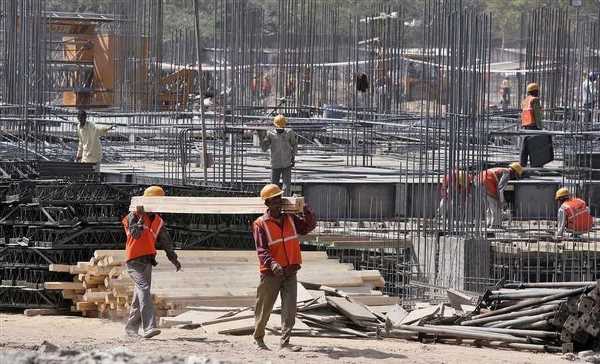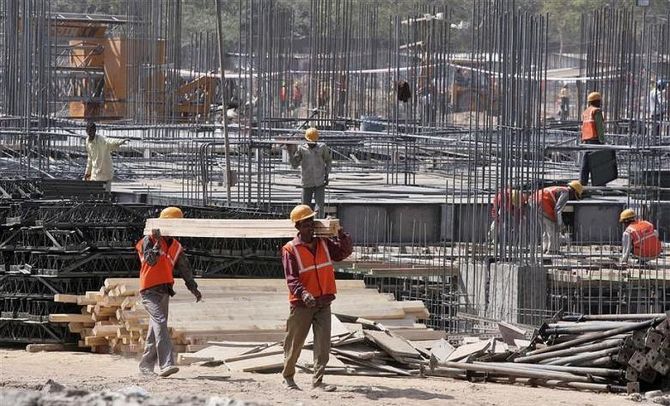Notwithstanding expectations of a pick-up in construction activity during a seasonally strong January-March quarter (fourth quarter) of 2022-23 (FY23), analysts are cautiously optimistic about the building material sector — encompassing paints, pipes, wood panels, tiles, metals, and cement — as volatile input costs, coupled with fears of a global slowdown, are making demand projections uncertain.
Against this backdrop, analysts suggest investors stay selective and pick stocks of companies with stronger brand recall, expanding distribution network, diversified product profile, healthier balance sheet, and sustainable cash flow.
“The government’s various proposals under Budget 2023-24 (FY24) may lead to the building material segment growing between 8 per cent and 12 per cent for the next five years.
“However, disruptions in the supply chain, a rise in the price of key input material, slowdown in domestic real estate, delay in commissioning or a slower ramp-up of newer capacities could delay growth,” said Anil Rego, founder and fund manager, Right Horizons.
Meanwhile, the budgetary allocation towards capital expenditure was raised to Rs 10 trillion for FY24, up from Rs 7.5 trillion for FY23.
Allocation towards affordable housing via Pradhan Mantri Awas Yojana, too, was pushed upwards to Rs 79,000 crore for FY24, from Rs 48,000 crore for FY23.
According to a report by Prabhudas Lilladher, the Indian real estate sector grew at 10 per cent compound annual growth rate (CAGR), from $50 billion in 2008 to $120 billion in 2017, and is expected to see 17.7 per cent CAGR to $1 trillion by 2030.
Since demand for home building material is directly correlated to the real estate market’s growth, the combined market size of the allied sector could touch Rs 2.7 trillion by 2025-26, from Rs 1.3 trillion in 2021-22, said the brokerage.
However, volatile input costs, amid renewed geopolitical tensions, may cloud near-term outlook.
Among the lot, plastic pipe companies are the most preferred pick across brokerages as companies are aggressively focusing on innovation, product launches, and market opportunities beyond plastic pipes and fittings.
Astral Pipes has entered the bathware industry, which has a market size of Rs 15,000 crore versus the plastic pipe market size of Rs 38,500 crore.
Prince Pipes and Fittings, too, has guided for the launch of its bathware product portfolio by March-April of this calendar year (CY23).
“Organised players account for 67 per cent of the total plastic pipe market. The industry grew at 10-12 per cent CAGR between 2014-15 and 2019-20, with demand likely to expand at 12-14 per cent CAGR between 2020-21 and 2024-25 (FY25) to reach more than Rs 60,000 crore by FY25 amid increase in government spending towards irrigation, water supply and sanitation projects, urban infrastructure, and replacement demand.
“We initiate coverage on Astral Pipes, Finolex Industries, Prince Pipes and Fittings, and Supreme Industries with a ‘buy’ rating,” said Prabhudas Lilladher.
Moreover, strong growth in a fixed asset investment upcycle across industrial, infrastructure, and residential-end markets, according to equity research analyst Shrinidhi Karlekar of HSBC Securities and Capital Markets (India), will drive double-digit revenue growth for Polycab India and KEI Industries, within the cables and wires segment, in CY23 and FY24.
Metals, too, remain a bright spot as the prices of coking coal — one of the key input raw materials — have plunged over the past few days with easing supply concerns.
“The demand for long steel has remained firm on the back of the government’s push to fast-track infrastructure projects.
“As Indian markets slowly scout European markets, after the roll-back of export duty and constraints faced by Turkey after the earthquake, the near-term outlook seems positive with price hikes expected in the coming weeks,” said Motilal Oswal Financial Services.
It has a ‘neutral’ rating on Tata Steel, JSW Steel, and Vedanta, and a ‘buy’ on Hindalco and Jindal Steel & Power.
Analysts remain cautious on cement, wood panel, and tiles as elevated input costs and weak export markets may dent sustainable volume and margin recovery.
Source: Read Full Article
-
From Hindustan Unilever to Britannia, FMCG stock rally skates on thin ice
-
Tillamook Recalls Certain Waffle Cone Swirl Ice Cream Packaged In Chocolate Peanut Butter Carton
-
IFC Films Ups Harris Dew To SVP & General Manager Of IFC Center
-
Cognizant splits global growth markets by appointing 2 internal leaders
-
U.S. Stocks May Extend Yesterday's Pullback In Early Trading


